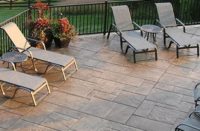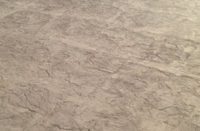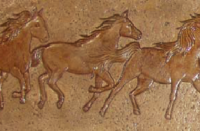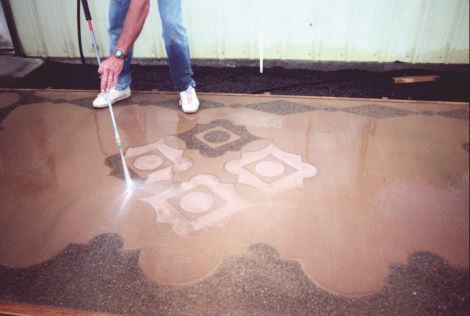
If you’re into stamping concrete (and who isn’t these days?), here’s a tool that should be part of your repertoire. Concrafter LLC design stamps — the brainchild of Theo Hunsaker and his sons, Kip and Sean, out of Vernon, Ariz. — require no special forming or pouring to create decorative edges. The process is so simple and fast, the Hunsakers say, you’ll literally gain “the edge” over the competition once you master the technique.
Describing the process as the “ultimate in edge and inset imprint finishes,” Sean points out that you integrate these unique design mats right into your normal monolithic concrete pouring process. “One pour, one day,” he stresses. “No custom form building. No joints that can cause the decorative edge to break away from the field.” And, as a bonus, these versatile tools that you use to create insets on concrete slab, you can use just as easily on tilt-up construction, stucco, plaster, drywall mud, curbing, concrete countertops or overlays.
“It’s a great way to dress up existing driveways without having to spend a lot of money,” Sean says. Not to mention, he adds, the designs don’t have joints such as those found in random stone patterns, so it’s easy to keep the area clean.
Benefits of the Concrafter
Since the imprinted design is a light profile, “It will outlive the other stamping methods two to one because you’re not fracturing the surface,” says Kip. “And we’ve done plenty of both. This way requires a whole lot less maintenance.” In colder climates, he adds, you don’t have to worry about spalling either.
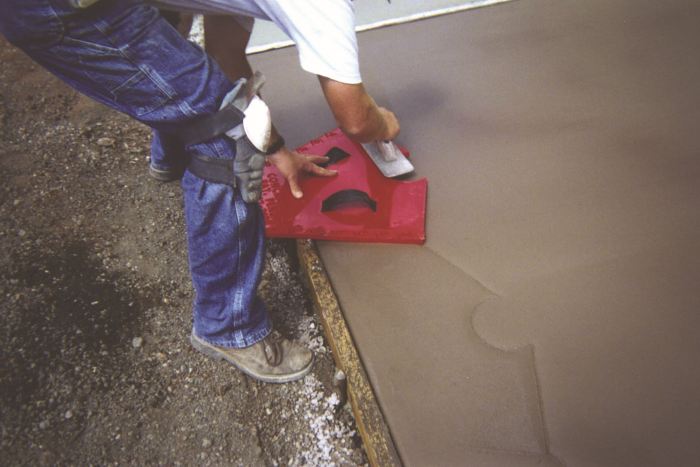
“You only need two mats to do any size job,” Sean says. “You don’t use a powder release or liquid agent because the stamping is done a little later when the surface isn’t as sticky or as susceptible to sticking to the mats. Plus, our mats have a perfectly smooth surface so they don’t create the vacuum that others do when they’re being pulled up. You can actually stay clean while you stamp.”
The whole process, he says, is “a lot less messy, a lot less time consuming and not as labor intensive as other stamping methods.” A 1,500-square-foot driveway, for example, typically takes two days — from prepping and pouring to finishing and sealing — to complete.
“We can take a highly defined design and stamp it in for staining purposes in a fraction of the time it takes someone to lay out similar designs and sawcut and stain them,” Sean says. “I stamped out a 2-foot-long pattern design in 30 seconds. I asked another contractor how long it would take him to do something comparable, to lay out that kind of detail. He said it would take him a half-day to lay it out and then two to three hours to sawcut it just to get it ready to stain. It literally took me 30 seconds. That’s how fast it goes on fresh concrete.”
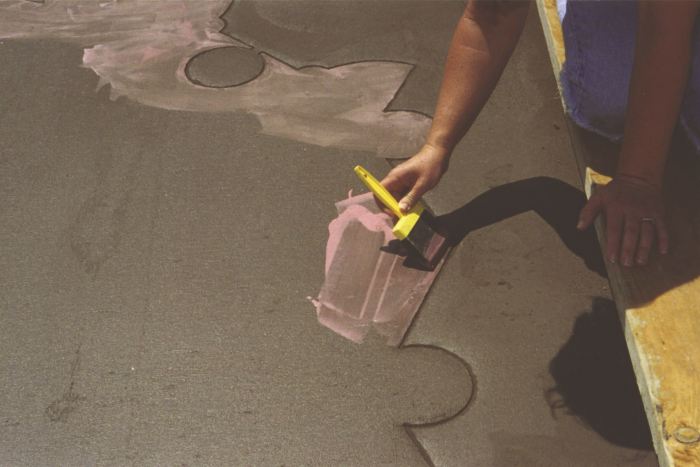
Simple and easy to use
Unless you’re doing centerpieces — which you can create with the same two mats — you don’t get out on the slab. And you don’t walk on the mat either; you just tamp it lightly into the surface by hand or with a hand float. When an imprint is done, you simply lift and re-place the mat to repeat the pattern.
The company introduced this tool at the World of Concrete in 2000. It is “the only stamping or design tool on the market that has a built-in measuring system that allows you to easily form borders from 2 to 18 inches wide,” Theo explains. When the concrete sets to the brooming stage, simply place the design stamp at the desired width of the border using the measurement guides on each edge of the stamp to keep the border uniform and tamp with a hand float.
“If I want a 10-inch border, I line up the 10-inch markings on the form,” Sean explains. It’s that simple. “Just follow the leading edge.” The tools are designed to follow any form or shape. They range from a radius or a curve to a straight edge or angle. They are great for both horizontal and vertical applications.
To date, there are 35 different designs available. These include Mediterranean and Southwestern motifs, as well as Grecian keys, vines, waves and finials. “We add new designs regularly and continue to find more ways to use the current ones we have,” remarks Theo. He added that their signature series can be integrated one with the other to create even more designs.
But the choices don’t stop there. After making the imprint, contractors have several options. You can leave it as is, or you can stain or color it. You can also apply a retardant where you want to expose the aggregate.
The economical option
Besides its ease, the Concrafter method is economical, Sean says. Instead of a 40 percent to 50 percent net profit, contractors can expect 60 percent to 75 percent profit. This is because the amount of materials used is much less than with traditional stamping methods. Instead of sealing the whole slab, he says, “you only need to seal the stained or exposed areas.” And you don’t even need to do that, Kip interjects, “but it greatly enhances the look if you do.”
“Contractors will often look at our work and ask ‘How in the world do you do that?’” Sean says. “But after they’ve attended one of our seminars they see that it’s really a piece of cake.”

